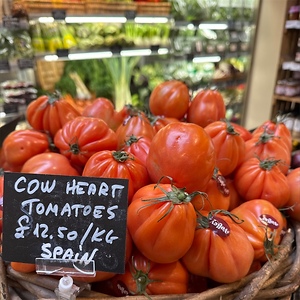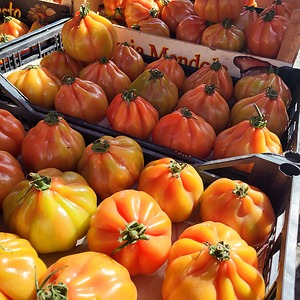


Oxheart Tomatoes
Estimated Inventory, lb : 0
Description/Taste
Oxheart tomatoes are typically large, varying in size and shape, depending on the specific variety. Most Oxheart tomatoes are harvested between 200 and 450 grams, but some varieties can reach over 900 grams in weight. Heirloom Oxheart tomatoes generally have a cordate-like shape with subtly curved, sloping shoulders tapering to a pointed tip. Other varieties categorized under the Oxheart name have an oblate, deeply ribbed appearance. Depending on cultivation and type, the tomato’s skin ranges from thin to thick and has a smooth, taut, and glossy nature. Oxheart varieties are also found in variegated shades of red, pink, white, yellow, brown-green, and orange. Underneath the surface, the pale red, orange, pink, or yellow flesh is dense, firm, and plump, encasing small cavities with little to no seeds. Oxheart tomatoes are known for their high flesh and low juice content, and the tomatoes have a tender, succulent, and lightly chewy nature. Oxheart tomatoes are edible raw when ripe and have a mild, sweet, moderately acidic, tangy, and savory flavor.
Seasons/Availability
Oxheart tomatoes are generally available in the summer through late fall when grown in open fields. Greenhouse and tunnel cultivation also allows tomatoes to be grown in the winter, creating availability in some regions year-round.
Current Facts
Oxheart tomatoes, botanically classified as Solanum lycopersicum, are a category of several varieties belonging to the Solanaceae, or nightshade family. The name Oxheart is generally used worldwide to describe tomato varieties that are typically large in size, dense, meaty flesh, and sweet and acidic in nature. Oxheart tomatoes are indeterminate beefsteak types, meaning the vining plants produce tomatoes throughout the growing season. They are also mostly heirloom varieties, with some modern hybrid cultivars labeled under the same name. Worldwide, Oxheart tomatoes are also known as Bull’s Heart, Cow’s Heart, Beef Heart, and Bovine Heart tomatoes. There is variation within the Oxheart category, as many varieties are found in various colors. Some common varieties include Pink Oxheart, Yellow Oxheart, Orange Oxheart, Giant Oxheart, and Red Oxheart. Each country also has more specific and uniquely-grown cultivars found in home and commercial gardens. Oxheart tomatoes are a specialty crop harvested by hand for culinary use and are valued by consumers and chefs in raw or cooked preparations.
Nutritional Value
Oxheart tomatoes are a source of vitamin A to maintain healthy organ functioning, vitamin C to strengthen the immune system, folate to develop DNA and RNA, and lycopene, an antioxidant that helps to protect the overall health of the body and fight against free radicals. Tomatoes also provide fiber to regulate the digestive tract, potassium to balance fluid levels within the body, iron to produce the protein hemoglobin for oxygen transport through the bloodstream, calcium to build strong bones and teeth, and other nutrients, including vitamin K and phosphorus.
Applications
Oxheart tomatoes have a sweet and acidic taste suited for fresh and cooked preparations. The variety’s thick nature allows it to be sliced and served on sandwiches or toast, and in Italy, it is a popular base for Caprese salads, layering a mixture of basil and mozzarella drizzled in olive oil and salt. Oxheart tomatoes can be eaten as a standalone snack, sprinkled with a touch of salt, or they can be chopped into salsa. Try using Oxheart tomatoes for bruschetta and gazpacho or blending and freezing them into a unique granita variation. In addition to fresh preparations, Oxheart tomatoes are often cooked and incorporated into sauces for pasta and risotto. Oxheart tomatoes have a low juice content, allowing the flesh to be grilled, roasted, and sauteed without falling apart. The tomatoes can also be breaded and fried, added to tarts and tarte tatin, or studded with meats, vegetables, and grains. In France, Oxheart tomatoes are used to make ratatouille, and in Spain, tomatoes are cooked with onions, garlic, eggplant, and squash as a flavorful side dish. Oxheart tomatoes pair well with herbs such as basil, oregano, and thyme, meats including beef, poultry, and veal, seafood, and vegetables such as asparagus, artichokes, eggplant, celery, and mushrooms. Whole, unwashed Oxheart tomatoes have a short shelf life and will keep for 1 to 3 days when stored at a cool, dry, and dark location at room temperature. Tomatoes can also be frozen whole or in pieces for extended use.
Ethnic/Cultural Info
Oxheart tomatoes obtained their name from the tomato’s similarity in shape to the heart of an ox, also known as a bull. This animal’s heart is often large and has a gentle, cordate-like shape, reminiscent of the tapered shape of many heirloom Oxheart tomato varieties. In France, Oxheart tomatoes are known as Coeur de Boeuf, translating to “Bull’s Heart” or “Beef Heart,” and in Italy, the tomatoes are referred to as Cuore di Bue, meaning “Ox heart.” It is important to note that since their rise in popularity among consumers in the early 21st century, many new hybrid varieties have been created and sold under the general Oxheart name. It has become challenging to distinguish between heirloom Oxheart varieties and hybrid varieties, and there is some discrepancy between flavor, texture, and taste. Researchers have noted that some hybrid varieties lack the balanced, sweet, and acidic flavor of heirloom cultivars. Some hybrids have also been produced for high yields and shipping, causing the tomatoes to have thicker skin. There has been a movement to attempt to categorize Oxheart tomatoes, but each country has its own varieties, making it challenging to create a unified standard.
Geography/History
Oxheart tomatoes are descendants of wild tomato species native to South America. Wild tomatoes spread naturally through animal droppings, animal seed dispersal, and human migration, expanding their range from South America into Central America and Mexico. Wild tomatoes were cultivated over time through civilizations, including the Incas, Mayans, and the Aztecs, and the tomatoes were selectively bred for improved culinary characteristics. In the early 16th century, Spanish conquistador Hernán Cortés encountered several types of tomatoes in the Aztec city of Tenochtitlan, now modern-day Mexico City, and carried the seeds back to Spain. The Spanish are thought to have encouraged the spread of tomatoes throughout Europe, especially in the Southern Mediterranean. At the time, Spain had several colonies based in what is now Southern Italy, and these cities were given tomato seeds to nobility as a curiosity. Tomatoes were being grown in Italian aristocratic gardens by the 1540s, and the first written record of tomatoes in Europe was made by Italian botanist Pietro Andrea Matthioli in 1544 in his work “Di Pedacio Dioscoride Anazarbeo Libri cinque della historia, & materia medicinale.” By the mid-17th century, tomatoes were utilized in culinary recipes in Southern Italy and later became common in Northern Italy in the late 18th or early 19th century. Tomatoes also spread in culinary use throughout Europe, thanks in part to European men taking their Grand Tours to the Mediterranean and trying tomatoes, and were adopted into other parts of Europe, including France. Tomatoes were also introduced into Russia and were carried to the United States in the late 18th century. The exact date of origin for Oxheart tomatoes is unknown, but the tomatoes were said to have been created through selective breeding, possibly in Italy. Oxheart tomatoes were known by the 20th century and were featured in seed catalogs in Italy, France, Russia, and the United States. Since their appearance in cultivation, many varieties have been bred and generally labeled under the Oxheart name, making it challenging to trace the history of true heirloom cultivars. Today, Oxheart tomatoes are commercially grown and planted in home gardens worldwide. Italy and France are two countries known for their Oxheart tomatoes, and in Italy, the tomatoes are grown in Sicily, Liguria, Abruzzo, Sardinia, Campania, Piedmont, and Tuscany. In France, the tomatoes are planted in Brittany and Pays de la Loire. They are also a popular home garden variety found throughout the United States. When in season, Oxheart tomatoes are found in local markets and select specialty retailers worldwide. The Oxheart tomatoes featured in the photograph above were sourced through Mercato Trionfale in Rome, Italy.
Recipe Ideas
Recipes that include Oxheart Tomatoes. One
| Wholesome Cook |
|
Ultimate Italian Tomato Salad on Olive Oil Toast |
Podcast

















